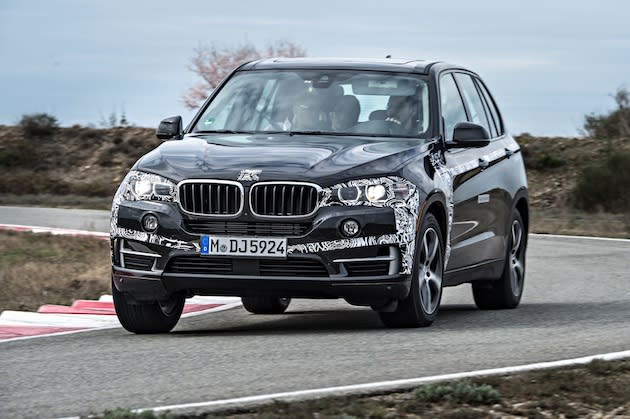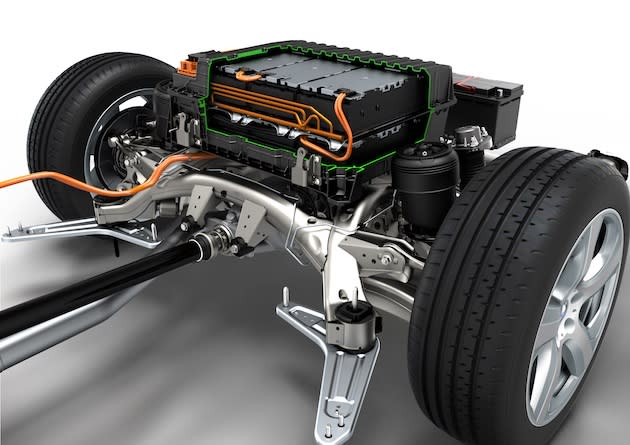BMW X5 eDrive Prototype review

Miramas, France -
It’s experimental, a cross-country SUV, and a hybrid-hybrid of BMW X and BMW i car technologies: welcome to the prototype plug-in X5
The new BMW X5 has been tested extensively by the CarBuyer team, and we've all found it to be a much improved vehicle and better in every respect, just as any new version of a modern car should. But the X5 I’m driving around Miramas’ twisty handling circuit is very different from the ones my colleagues have manhandled and brutalised (in a loving way) across one big country and one small island.
The conceptual idea of an SUV is a vehicle that will take you to the country and let you eat a lot of peaches, by using its off-road capability while you engage in various sporty and emotional activities. But BMW shockingly reveal, in Miramar, that the vast majority of X5 owners actually drive 30km or less per day.
With the company’s new electric and electric-hybrid vehicle efforts under the sub-brand i now in full swing around the world, you can see where this is going: add i-ness to the brand’s largest and likely least fuel efficient vehicle where it’ll make maximum impact and you end up with a plug-in, petrol-electric hybrid version of the X5.
While the car was originally announced for launch this year, BMW’s engineers now say the project is still on track but shy from directly announcing a debut timeframe, only that it won’t be launched in 2014 – so 2015 it is, then. With European rules on car model fleet emissions and the tech readily on hand with economies of scale to assist, it’s a definite maybe that BMW will build the plug-in X5.
And it should, because having tried it out on track, we think it’s a brilliant piece of machinery. while the newest X5 comes in xDrive35i and xDrive50i editions, the eDrive model has the same 2.0-litre turbocharged engine from the BMW 328i under the hood – but not in the same spot. Like in a sports car, the engineers have pushed the engine back towards the cabin. The X5 has enough space that this isn’t an issue, and it’s obvious peering into the engine bay how far back the radiator now is.
The downsized engine is joined by a electric motor-generator sandwiched between the eight-speed ZF gearbox and the engine, it packs 94bhp and 250Nm of torque. It charges, and is powered by a 9kWh battery pack that resides in the car’s boot. Engineers say they don’t have a confirmed kerb weight figure, but the car should weigh about the same as an xDrive50i, or roughly 2.2-tonnes.
We began our drive in fully electric mode, with the car doing a great impression of the BMW i3 – it rides tall as well, although the fat tyres make more noise and it’s more refined than its tiny sibling. In this mode, which is selectable by a button (duct taped over in the experimental car), the car can hit a top speed of 120km/h with a range of 30km – in other words, enough for 80 percent of X5 owners, and most drivers too.
Getting on the ‘gas’ the X5 accelerates away in a suitably stately manner, but it’s obviously not as lively as the half-as-heavy i3. When you engage kickdown on the accelerator the 2.0-litre turbo engine itself kicks in automatically, and smoothly too although there is a perceptible judder.
The X5 eDrive will also benefit from other techniques in the i programme, such as route planned energy management. For example if your navigation brings you from a less crowded area then into the city, the system can plan to use the combustion engine for cruising and switch over to EV mode for stop-and-go work. Conventional modes also exist, Eco Pro makes all systems do their best to extend range, while in Sport mode both engine and motor/battery work to deliver the most go.
The latter gives the X5 much more poke, although even at full blast it’s more brisk than outright fast, and certainly not as quick as a 50i. But it’s pleasing enough, even if it doesn’t sound particularly distinguished, it doesn’t feel weedy or in need of more power.
Where the X5 comes up with roses again is in its tidy and sharp handling. The handling circuit is only one and a half lanes wide, but positioning the car for tricky turns was a pleasure, and a feeling intensified by being able to see very well in all directions. If anything, customers can rely on the fact that an X5 eDrive will still be one of the more vivacious handlers in the big SUV class.
The only drawbacks we can think of is that in Singapore, take-up will be limited to owners who have access to their own secure charging points. The seven-seat option will also likely be impossible, since the battery pack occupies the area below the boot, although the loading area is not impinged on much at all. With all this said, we think the most mixed-up X5 is all crossed up in a very good way, and BMW should charge ahead with it.
BMW X5 eDrive
Engine 1,998cc, 16V, turbocharged, inline 4
Power 245bhp at unknown rpm
Torque 350Nm at unknown rpm
Motor 94bhp, 250Nm
Battery Lithium ion, 9kWh
System total 270bhp, more than 400Nm
Gearbox 8-speed automatic
Top Speed TBA
0-100km/h TBA
Fuel efficiency 3.8L/100km
CO2 89g/km
Availability 2015
Also consider: BMW 3 Series Hybrid





